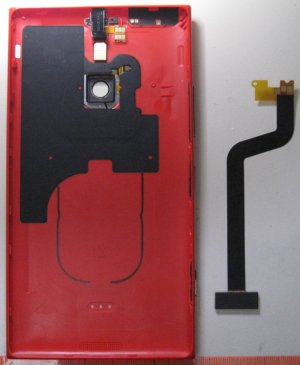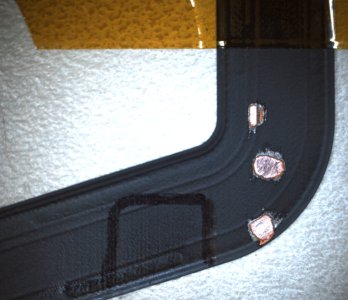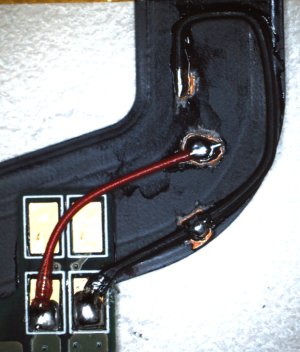I have completed 3 more of these mods now, and I have some better pictures to share of the process. Should definitely be enough information here to understand the process. I've been using Lumia 920 Qi charging modules for my modifications, and it's been working fantastically. I'm not really inclined to try and improve the performance since it works as well as it does. There's very little I could do at this point to simplify this modification any further.
Let's begin.
Step 1: Open the 1520 and lay out the back shell with the PMA flex visible.
 Step 2:
Step 2: Mark the ideal location of the Qi coil placed as shown above, so that the main body of the coil sits
underneath the PMA flex, while the contact pads sit
on top of the flex. Use a Sharpie or fine-point permanent marker to trace an outline of the coil body into the plastic shell, as well as lines along each side of the PMA flex sitting centered down the spine of the coil. Finally, trace an outline of the Qi coil contact pad onto the black PMA flex so that you know exactly where it will later be permanently positioned.
 Step 3:
Step 3: Remove the Qi coil, then remove the PMA flex from the 1520 back shell by gently lifting the PMA flex contact pad near the camera lens up and away from the shell. Next, use a paper clip or smooth, flat tweezers (Style 2A from Techni-Tool) to gently lift up the PMA external contact plate up and away from the shell. This should completely release the PMA flex from the 1520 back shell. Set it aside, but protect it from contamination because you will need to recycle the adhesive at both ends of the flex. You should be left with a shell showing an outline of the 920 Qi coil placement as shown above.
 Step 4:
Step 4: Using the close-up provided above, use Style 2A tweezers or something else with a sharp but blunt pointed edge to scrape away the black mylar mask off the PMA flex in the areas shown above. Note the outline of the 920 Qi coil drawn earlier just to the left, so you know where to make the alterations. Do not scrape into/past the copper traces in the PMA flex, or you'll have to make new holes further up the flex and insulate the ones you ruined. This is the riskiest part of the procedure, so take your time and do it right -
and carefully. I do this part under a 20x scope...

Step 5: Carefully tin the newly exposed copper on the PMA flex. Use solder flux. I recommend a 2 to 4mm soldering tip. No blobs. Do not add an excessive amount of solder, but add enough to make a good joint between the copper trace and the bus wire added in the next step.
 Step 6:
Step 6: Using the picture above as a guide, carefully solder a length of red and black solid core bus wire as shown, and be sure to leave sufficient length to solder to the 920 Qi coil charging pads. Ensure that there are no shorts between the two circuits (positive and negative), but DO make sure that both grounds (negative) are connected or the modification won't trigger charging.
 Step 7:
Step 7: Complete the soldering by placing the 920 Qi charging coil in the previously marked position on the PMA flex, so that the contact pad sits on top of the black PMA flex, and the Qi coil body sits
under the PMA flex. Note that the gold pads on the 920 Qi charging coil are soldered to the Qi coild circuit board underneath, and they
WILL try and come off or wiggle around when you heat the gold pad up. Be ready for this, and hold the gold pad in place to prevent movement. If the pad comes off, no big deal (don't try to replace it) - just solder the bus wire to the 4 tiny pads where the gold pad used to be. Once your soldering is complete, it should look like the picture above. Check it for shorts and correct any mistakes you find. Clean up any flux using 3M Novec or 99% Isopropyl alcohol. If you use Q-Tips to d?uche the area clean, use some scotch tape to remove any cotton fibers that will be shed by the Q-Tip(s). Make sure the area is dry of any solvents before proceeding.
 Step 8: (Optional)
Step 8: (Optional) I recommend adding a strip of 3M laminating adhesive to the top spine of the 920 Qi charging coil to hold the PMA flex in place, and to act as strain-relief for the soldered connections. Since I recycled these 920 coils from broken 920's, I also added the same laminating adhesive to the other side of the Qi coil, but I think new coils already come with fresh adhesive on that side. Center the PMA flex down the spine of the Qi coil using the lines you drew on each side from step 2. Attach the PMA flex to the adhesive strip and press to seal.
 Step 9:
Step 9: Using Kapton tape or another polyamide tape, insulate the soldered areas as shown above. Use a sharp X-Acto blade to trim away any excess. Avoid wrinkling the tape.
 Step 10:
Step 10: The final product, with some "branding" added. This is ready to install in any AT&T 1520.
Step 11: Remove the two rubber spacers in the back shell, that normally sit on either side of the PMA flex (if you haven't already).
Step 12: Remove the double-sided adhesive backing on your 920 Qi coil and get it into position in the back shell, but don't press it down to seal just yet. First verify that the top part of the PMA flex fits into the keyway near the camera lens and press it down to re-activate the old adhesive. Clean off any finger oil you get on the gold contact plate. Then press the external contact PMA flex plate back into the holes in the shell (this may require more pressure than you think). Once those two ends of the PMA flex are in place, the Qi coil should already be centered right where it needs to go. Gently press to seal it into the back shell.
Step 13: Re-assemble the device and test your modification.
Ok, I think that's probably the limit of my contributions on this matter. Good luck, guys, and I hope you'll kick AT&T in the knuts if the opportunity presents itself. Better still, you could fuƈk with them and take your newly modified 1520 to an AT&T store, and "shop" for Qi-chargers. Have your 1520 out, in hand. When they see that you're trying to shop for a Qi charger for your 1520, they'll bravely try to be the hero and correct you towards the PMA solution. Then you can correct
them and make THEM jealous... Muhahahaha... (insert sinister smirk here) :winktongue:
Cheers,
SonarTech













